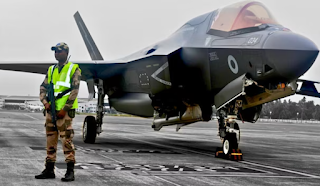The saga of the British Royal Navy’s F-35B Lightning II fighter jet, stranded for 10 days at Thiruvananthapuram International Airport, continues to capture global attention — not just for its strategic implications, but also for the surreal optics of a $110 million fifth-generation stealth jet sitting idle on a civilian runway in Kerala.
🛬 Why the F-35B Landed in India
-
On June 14, the jet made an emergency landing after transmitting SQUAWK 7700, the universal distress code, near the Kerala coast.
-
The jet was reportedly flying from HMS Prince of Wales, a British aircraft carrier 100 nautical miles offshore, during joint drills in the Indian Ocean.
-
Initial reports cited low fuel and bad weather as the causes for the diversion. However, it was later confirmed the aircraft had also suffered a hydraulic system failure.
⚙️ Why Is It Still Grounded?
-
After landing, the hydraulic failure worsened.Hydraulics are vital to:
-
Landing gear deployment
-
Brake systems
-
Flight control surfaces (e.g., flaps, rudders)
-
-
British technicians from the carrier attempted multiple fixes but were unable to restore the system, rendering the aircraft unfit to fly.
-
Despite India offering to tow the jet to a hangar to shield it from monsoon rains, the UK reportedly declined, possibly due to security protocols and parts sensitivity.
✈️ What Happens Now?
-
The most likely outcome if repairs continue to fail: the F-35B will need to be airlifted back—either to the UK or HMS Prince of Wales.
-
This would require a large military transport aircraft, like a C-17 Globemaster III, specially fitted to handle heavy, stealth-sensitive assets.
-
Alternatively, the jet may be partially dismantled and flown out in sections.
🔍 Why This Is a Big Deal
-
The F-35B isn’t just any fighter jet. It’s a top-tier stealth asset, capable of short take-offs and vertical landings, used by only a select group of NATO nations.
-
Its presence in India—unplanned and prolonged—has led to:
-
Social media frenzy (e.g., fake OLX ad listing it at $4 million)
-
Speculation about tech exposure and intelligence risk
-
Diplomatic coordination between India, UK, and the US, since the jet is a Lockheed Martin product and involves classified systems
-
🇮🇳 India’s Role
-
The Indian Air Force (IAF) responded promptly, facilitating a safe landing and providing fuel and perimeter security (via CISF).
-
The episode plays out as India itself is moving closer to human spaceflight, and is in talks for future high-end fighter acquisitions, including the AMCA and possibly Western 5th-gen aircraft.
-
Though US President Donald Trump previously offered F-35s to India, there’s no formal deal in place yet.
🚨 Strategic and Symbolic Undercurrents
-
This event inadvertently symbolizes both the strengths and vulnerabilities of modern airpower—how even elite aircraft are grounded by small failures.
-
It also serves as a case study in military logistics, international cooperation, and the challenges of operating cutting-edge tech in real-world environments.
As of now, there’s no official timeline for the jet’s removal. Until then, the $110 million stealth marvel remains an unexpected—and rain-soaked—guest on Indian soil, guarded round-the-clock and watched by the world.



